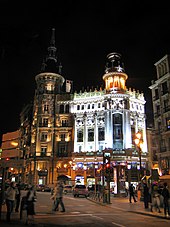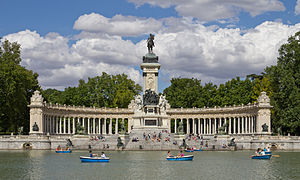MADRID : The capital city of Spain and the third-largest city in the European Union .
The capital city of Spain
Madrid is a south-western European city, the capital of Spain, and the largest municipality of the Community of Madrid. The population of the city is almost 3.2 million with a metropolitan area population of approximately 6.5 million. It is the third-largest city in the European Union, after London and Berlin, and its metropolitan area is the third-largest in the European Union after London and Paris.The city spans a total of 604.3 km2 (233.3 sq mi)
The Madrid urban agglomeration has the third-largest GDP in the European Union and its influences in politics, education, entertainment, environment, media, fashion, science, culture, and the arts all contribute to its status as one of the world's major global cities.Due to its economic output, high standard of living, and market size, Madrid is considered the major financial centre of Southern Europe and the Iberian Peninsula; it hosts the head offices of the vast majority of major Spanish companies, such as Telefónica, Iberia and Repsol. Madrid is the 17th most livable city in the world according to Monocle magazine, in its 2014 index.
Madrid houses the headquarters of the World Tourism Organization (UNWTO), belonging to the United Nations Organization (UN), the SEGIB, the Organization of Ibero-American States (OEI), and the Public Interest Oversight Board (PIOB). It also hosts major international regulators of Spanish: the Standing Committee of the Association of Spanish Language Academies, headquarters of the Royal Spanish Academy (RAE), the Cervantes Institute and the Foundation of Urgent Spanish (Fundéu BBVA). Madrid organizes fairs such as FITUR, ARCO, SIMO TCI and the Cibeles Madrid Fashion Week.
While Madrid possesses modern infrastructure, it has preserved the look and feel of many of its historic neighbourhoods and streets. Its landmarks include the Royal Palace of Madrid; the Royal Theatre with its restored 1850 Opera House; the Buen Retiro Park, founded in 1631; the 19th-century National Library building (founded in 1712) containing some of Spain's historical archives; a large number of national museums, and the Golden Triangle of Art, located along the Paseo del Prado and comprising three art museums: Prado Museum, the Reina Sofía Museum, a museum of modern art, and the Thyssen-Bornemisza Museum, which completes the shortcomings of the other two museums. Cibeles Palace and Fountain have become the monument symbol of the city.

The Royal Palace (Palacio Real) is surrounded by three green areas. In front of the palace, are the gardens of the Plaza de Oriente; to the north, the gardens of Sabatini and to the west up to the Manzanares River, the famous Campo del Moro. Campo del Moro gardens has a surface area of 20 hectares and is a scenic garden with an unusual layout filled with foliage and an air of English romanticism. The Sabatini Gardens have a formal Neoclassic style, consisting of well-trimmed hedges, in symmetric geometrical patterns, adorned with a pool, statues and fountains, with trees also planted in a symmetrical geometric shape. Plaza de Oriente can distinguish three main plots: the Central Gardens, the Cabo Noval Gardens and the Lepanto Gardens. The Central Gardens are arranged around the central monument to Philip IV, in a grid, following the barroque model garden. They consist of seven flowerbeds, each packed with box hedges, forms of cypress, yew and magnolia of small size, and flower plantations, temporary. These are bounded on either side by rows of statues paths, popularly known as the Gothic kings, and mark the dividing line between the main body of the plaza and the Cabo Noval Gardens at north, and the Lepanto Gardens at south.













Comments
Post a Comment